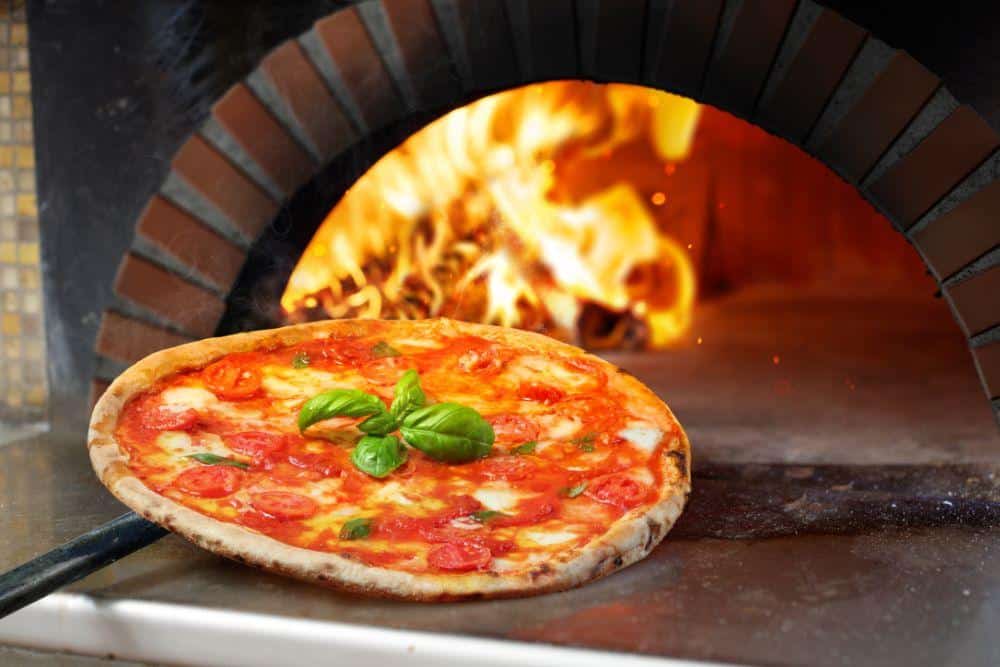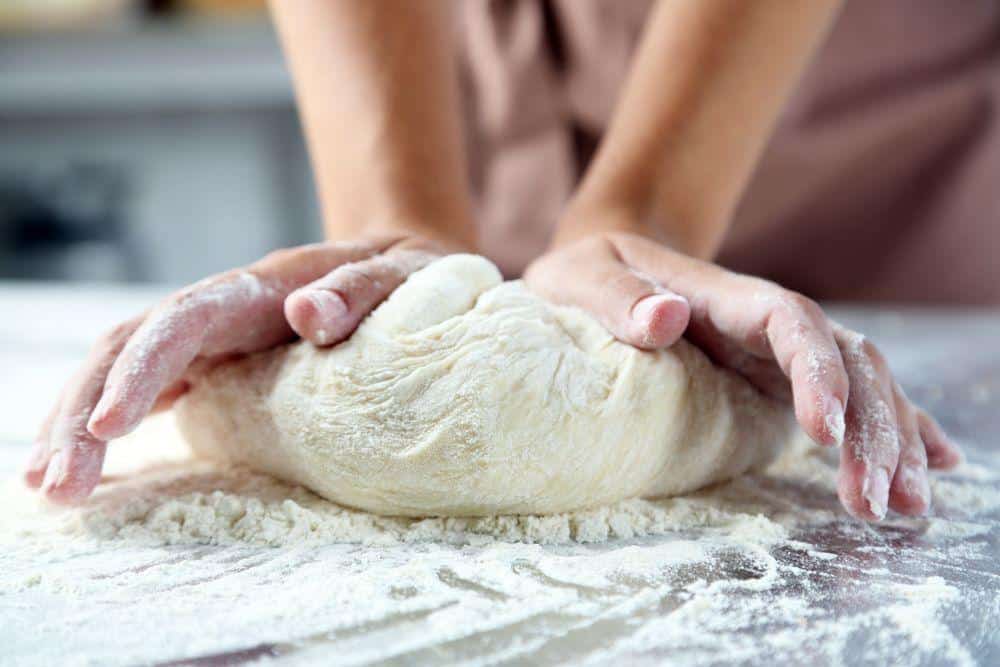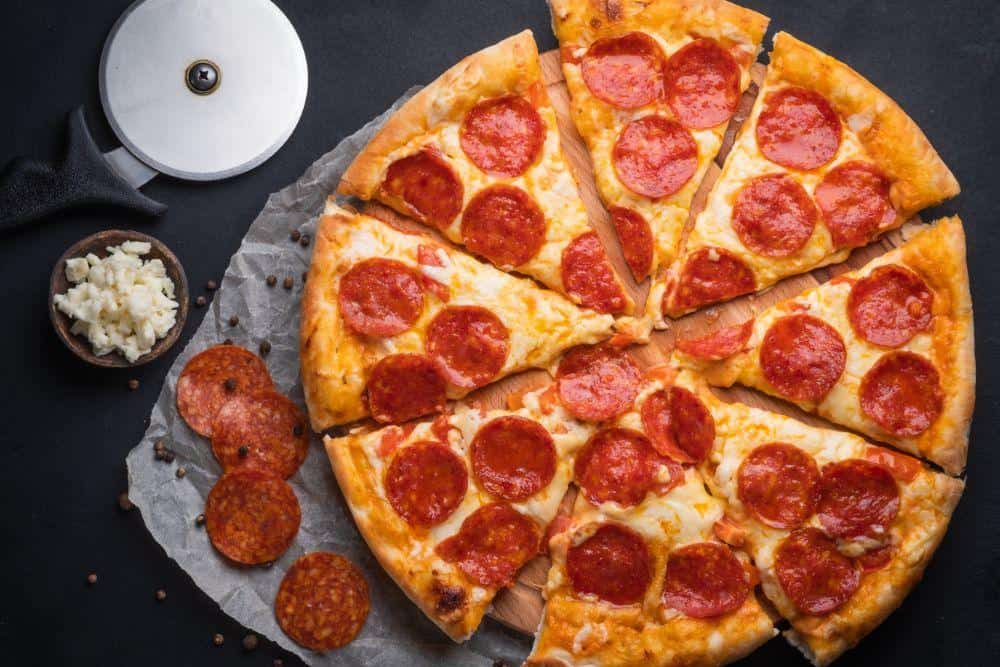If you’re trying to make the perfect pizza at home, a pizza stone is the way to go. Pizza stones can significantly impact the quality of your homemade pizza and will produce much better results than a metal baking sheet.
Ceramic pizza stones are preheated in the oven, so it’s hot before your pizza goes on. The preheated stone allows the pizza to heat faster right when it goes in, meaning that your pizza will be much airier. The porosity of the stone also draws out more moisture than metal, meaning that your crust will cook more evenly.
Overall, a pizza baking stone will mimic a stone fire oven more closely than any other options available for homemade pizza and is the best way to get the perfect pizza. Fortunately, that doesn’t mean you can’t get great results using other tools.
If you don’t have or don’t want a pizza stone, you can still get great results with a cookie sheet. A baking sheet won’t get as hot as a pizza stone, so if you’re using one, turn your oven up as high as you can and leave your pizza in the oven for a little longer.

There Are Many Different Methods That Can Help You Achieve a Deliciously Cooked Pizza
Pizza steels are heavy, solid slabs of steel used to make pizza in your home oven. They are generally more expensive than most other homemade pizza pan options but will give you some of the best results.
A pizza steel will do an even better job than a pizza stone. The metal in a pizza stone gets even hotter than a pizza stone, meaning it will do an even better job of getting your crust light and airy. The drawback is that pizza baking steels are often more expensive and heavier than pizza stones.
To make a pizza on a pizza steel, you should preheat the steel much like a pizza stone. Because it is such a large, thick piece of metal, this can take as long as 45 minutes, so ensure you have plenty of time.
Once your pizza steel is fully preheated, place your homemade pizza on it and let it cook. Fortunately, the preheating portion of the process is the longest part, as your pizza will only need to cook for ten minutes at most.
Pizza steels need care similar to cast iron pans. They need to be seasoned with oil to create a barrier that will prevent sticking. You should season your pan every time you find your pizzas sticking.
To season a pizza steel, you should choose an oil with a high smoke point, like avocado, peanut, sesame, or sunflower oil. Rub a fair amount of oil onto your steel and then bake it in the oven at about 400 degrees for an hour. The heat will polymerize the oil and create a non-stick surface.

Pizza Steels Are a Great Way to Make Pizza at Home
Pizza pans are flat, circular pans used for making pizza in ovens. They’re used in many commercial settings and can help you get a great crisp on your pizza for a much lower price than a pizza steel or stone.
There are two kinds of pizza pans, regular solid pans, and perforated pans. Perforated pizza pans have holes, so you can’t use them for much other than pizza and bread. The holes allow the pizza to have more contact with the oven's heat, creating a crispier crust than solid pizza pans.
Unlike with a pizza stone or pizza steel, you should make your pizza crust on the pizza pan instead of transferring it after rolling it out. You should use the highest possible temperature on your oven for the best results.
A cast iron skillet is a great choice to make a crispy, thick pizza at home. Just like with a pizza steel, ensure that your skillet is seasoned so your crust doesn’t stick. The sides of the pan will create a delicious, crispy crust on the outside, and the high temperature will ensure that your pizza is light and airy.
You can also use a cast iron skillet as a make-shift pizza steel by preheating it in the oven upside down. Toss your pizza onto the skillet when it’s thoroughly heated, and you should get good results without the expense and hassle of a pizza steel.
Pizza can be made directly on your oven’s rack if it is pre-cooked or frozen. Cooking a pizza from raw dough directly on the rack will cause it to fall through and make a mess. Even if your pizza is pre-cooked or frozen, you should place a baking sheet underneath during cooking to prevent unwanted spills.

You Can Even Place a Pizza Directly on the Oven Rack
Pizza stones, pizza steels, cookie sheets, and cast iron pans are all great options if you have an oven to use, but there are alternative options if you don't have an oven at all or don’t want to turn it on. If you’re looking to make a pizza without an oven, there are plenty of ways to get great results.
You can make a pizza in a microwave oven, but you will probably want a convection microwave. A convection microwave has a heating element and fans that act as a miniature version of a full-sized convection oven. A standard microwave will not cook a pizza well, if at all.
To use a convection microwave to make pizza, preheat your convection microwave as high as possible and place your pizza on foil to bake. Do not use foil in the microwave unless it is on the convection setting. Foil in the microwave while using standard modes is a fire hazard.
Lots of great recipes exist to make pizza in an air fryer. Air fryers act as small convection ovens and should result in an evenly cooked crispy crust if used correctly. To make a pizza in an air fryer, preheat the air fryer to 375 degrees and bake for about five minutes.
Make sure to use a smaller amount of crust to make a small pizza if you cook it in the air fryer. Don’t make a full-sized pizza and cut it to fit the air fryer, as the toppings will likely run off the slice without the crust to hold them in.
For the best possible results, use the air fryer crisper tray. The crisper tray will ensure that hot air can get underneath your crust, evenly cooking all sides of the pizza.
There are many types of toaster ovens, but most act as miniature conventional ovens. While a convection oven will likely get better results, a conventional or toaster oven will do a fine job. As with most options, you should heat your toaster oven to the highest setting possible when making a pizza.
If you’re having trouble getting your pizza just right, there are some things that you can do to improve your results and get the best pizza possible in your home kitchen.
If your pizza is coming out a little less crispy and airy than you’d like, preheat your oven for longer before putting it in. The extra time will ensure that your entire oven is hot, not just the place near the censor. This primarily applies to pizza pans and cookie sheets, as you should preheat your pizza steel or stone long enough that your oven will be fully heated.
If your pizza dough comes out soggy from the toppings, try baking your dough without toppings for a few minutes first. The initial cooking should help the dough crisp up and form a barrier that will keep the toppings from moistening your pizza dough.
If your pizza is sticking to your pan and the pan is fully seasoned or nonstick, consider using cornmeal instead of flour when rolling it out. Cornmeal is coarser than flour and will help your pizza roll easily on and off your pan.
There are many types of ovens, but most have a convection setting. The convection setting on your oven will circulate the air, making it heat more consistently and faster. This circulating air will heat your pizza evenly, making for a more crispy crust.
Distributing your toppings evenly so that there isn’t a large pile in the middle will help them and your crust cook evenly. The toppings may be the best part of the pizza, but if you’re struggling to get the right crispiness, it may be because you’re using too many. Try easing back on the topping if distributing them evenly isn’t fixing the problem.
There are a wide variety of tools to help you achieve the best pizzas you can at home, but some will help you more than others. Which tools you should invest in is largely a matter of personal opinion, but there are some general guidelines that will help you decide what to buy.
If you already have a pizza stone or steel, a pizza peel is an inexpensive way to get the most out of your tools. A pizza peel can help you get your pizza in the oven faster, keeping the heat up. A peel can also help you get a pizza back out of the oven more easily.
If you’re making pizzas frequently, having a specialized tool to cut them can be a considerable frustration-saver. Pizza cutters have a variety of uses outside of pizzas, such as cutting pasta, ravioli, or fondant. A rocker is a less versatile tool but does a better job of cleanly cutting through the crust.
Use a pastry brush to spread oil onto your crust before cooking. You can also use a spoon or a baster, but a pastry brush is not typically expensive and will get you the best results.
